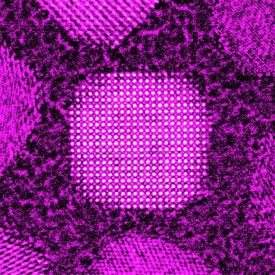

11/30/2018
 AIMR researchers have succeeded in imaging single surfactant molecules on the surfaces of metal oxide nanoparticles.
AIMR researchers have succeeded in imaging single surfactant molecules on the surfaces of metal oxide nanoparticles.
© 2018 Kazutoshi Inoue
By using state-of-the-art analysis techniques, AIMR researchers have mapped the distribution of valence states inside cerium oxide (CeO2) nanocubes1 and imaged single surfactant molecules on the surfaces of cerium oxide nanocrystals2. These findings will help make more-efficient catalysts and pave the way to design new functional materials.
Cerium oxide is an extremely versatile ceramic, being used in applications as diverse as solid oxide fuel cells, catalytic antioxidants for treating oxidative stress-related diseases, and catalytic converters for cleaning vehicle exhaust gas. Most of its interesting properties, including its extraordinarily high capacity to store oxygen, stem from the fact that the cerium cation has two stable valence states, Ce4+ and Ce3+, and can be repeatedly converted between them.
To gain insights into the mechanism behind the high oxygen storage capacity of cerium oxide nanocrystals, Yuichi Ikuhara and Tadafumi Adschiri of the AIMR at Tohoku University and colleagues used scanning transmission electron microscopy (STEM) and electron energy loss spectroscopy (EELS) to analyze the distribution of the two valence states within nanocubes of cerium oxide with sizes between about 5 and 12 nanometers. They discovered that, Ce3+ ions are concentrated near the surface of larger nanocubes but are almost absent in the center, where the Ce4+ valence state predominates. In contrast, nanocubes smaller than about 6 nanometers contain a significant amount of Ce3+ ions at their centers.
These findings will inform both fundamental and applied studies. “Our quantitative analysis of the valence state distribution, combined with local structural transformation, provides a basis for understanding the intrinsic features of cerium oxide nanocrystals,” notes Adschiri. “It will also provide critical guidance for designing and fabricating novel oxygen-storage materials that can be used as catalysts and solid electrolytes.”
In a related study, the researchers used STEM and EELS to examine how surfactants interact with cerium oxide nanoparticles. This is important since surfactants, which lower the nanocrystals’ surface energy, are indispensable for synthesizing metal oxide nanoparticles with controllable sizes and desired morphologies and are thought to play a key role in applications. The team succeeded in imaging single surfactant molecules on the surfaces of metal oxide nanoparticles — the first time such a high resolution has been achieved.
“We found direct evidence that surfactant coverage ensures the synthesis of well-dispersed ultrafine nanocrystals that do not clump together,” comments Ikuhara. “The direct characterization of single surfactant molecules of an organic surfactant on the surfaces of metal oxide nanocrystals will advance our understanding of the surface chemistry of surfactant-modified nanocrystals.”
The team will investigate the effect of adding dopants on the distribution of the valence state in ultrafine nanocrystals.
This research highlight has been approved by the authors of the original article and all information and data contained within has been provided by said authors.